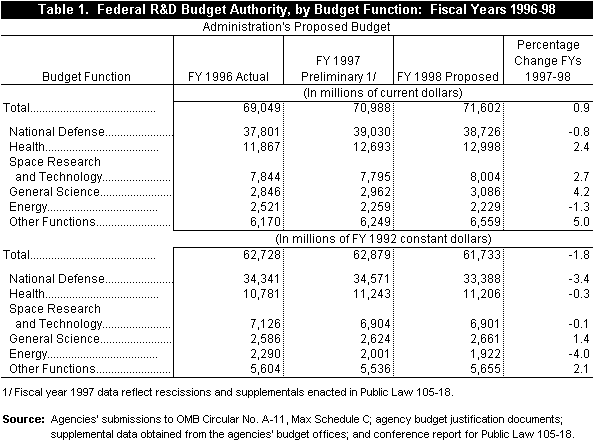
| Science Resources Studies Division | |
| DATA BRIEF |
Directorate for Social, Behavioral and Economic Sciences |
| President's FY 1998 Budget Asks for Slightly Lower Inflation-Adjusted R&D Spending |
By Ronald L. Meeks
|
This Data Brief presents the overall distribution and growth patterns of Federal funding of the research and development (R&D) components of agency programs, as proposed by the Administration for fiscal year (FY) 1998. The
discussion focuses on the five largest budget functions with respect to R&D funding-national defense, health, space research and technology, general science, and energy-that cut across agency lines. Although pending Congressional action will
determine the final budget authority for R&D, the information presented here highlights Federal agencies' submissions to the Office of Management and Budget in early 1997. How Congress and the Administration affect the outcome of R&D funding levels
will be known later in 1997.
The Administration proposed total budget authority of $72 billion for R&D programs in its FY 1998 budget, only 1 percent more than the preliminary FY 1997 R&D total of $71 billion (table 1). After adjusting for expected inflation, R&D budget authority would decrease by 2 percent. Details on Federal funding of the R&D components of agency programs for FYs 1996--98 will be available in the annual National Science Foundation (NSF) report, Federal R&D Funding by Budget Function: Fiscal Years 1996-98. |
|
|
Proposed Defense R&D A 1-percent drop (a 3-percent decline in constant dollars) is proposed in national defense R&D budget authority. Even with this proposed decline, defense will continue to account for more than half ($39 billion, or 54 percent) of the Federal R&D total (chart 1). The Department of Defense (DOD) expects its military research, development, test, and evaluation (RDT&E) budget to drop by nearly 1 percent (a 3-percent decline in constant dollars) to $36 billion over the FY 1997 funding level. R&D funding for the Department of Energy's (DOE's) atomic energy defense activities accounts for 6 percent of proposed FY 1998 defense R&D and would decrease 2 percent (a 5-percent decline in constant dollars) from estimated FY 1997 funding. DOE expects funding for stockpile stewardship, DOE's largest R&D atomic energy defense activity, to stay at the FY 1997 level. DOE also expects fewer dollars for environmental restoration and waste management programs (formerly threat assessment, down 14 percent) and naval reactors development (down 7 percent). Special technologies, nonproliferation, and nuclear safeguards and security will each be funded at the FY 1997 level. |
|
Proposed Nondefense R&D The nondefense share of Federal R&D budget authority has increased steadily from 37 percent in FY 1990 to an estimated 46 percent in FY 1998 (chart 1). The President's budget contains nearly a $1 billion increase in total nondefense R&D budget authority, to $33 billion. This level represents a 3-percent increase from estimated FY 1997 funding. In constant dollars, nondefense R&D is expected to remain flat. Among individual budget functions, health is slated for the largest FY 1998 R&D increase, $300 million above the FY 1997 level. Health-related R&D programs sponsored by the Department of Health and Human Services (HHS) would be funded at $13 billion (a 2-percent increase above the FY 1997 level but nearly flat in constant dollars). The bulk of the health account ($12 billion) will be allowances for programs of the National Institutes of Health (NIH). NIH's R&D funding for health activities is slated to increase by $352 million or 3 percent (nearly flat in constant dollars) in FY 1998. All 20 NIH institutes are slated to get increased R&D budgets. Although the National Cancer Institute is slated to get the largest portion (over $2 billion) of NIH R&D dollars, two other units, the Office of AIDS Research and the National Heart, Lung, and Blood Institute, are expected to receive more than $1 billion apiece. The National Aeronautics and Space Administration (NASA) has proposed a 3-percent increase in R&D budget authority for space research and technology activities, to $8 billion. The largest growth ($183 million) in the FY 1998 space research and technology account will be allowances for funding of the space station program. The second largest change is slated for space science programs, which will increase $75 million above the FY 1997 level. The Administration has proposed that research funding for general science increase by 4 percent, or $124 million in FY 1998, to $3 billion. Three-fourths of these dollars are slated for the National Science Foundation (NSF), with the remainder going to DOE. Major funded activities in NSF include mathematical and physical sciences; geosciences; engineering; biological sciences; computer and information sciences; and social, behavioral, and economic sciences. DOE's general science R&D is in support of high energy and nuclear physics. Energy R&D is budgeted at $2 billion in FY 1998, down 1 percent ($30 million) from the FY 1998 level. DOE anticipates a major drop in fossil energy research since the FY 1998 budget contains a proposal to cancel nearly $300 million in unspent, previously appropriated funds for clean coal technology. Three agencies provide support for R&D activities in energy: DOE, which would account for 94 percent of the funding in this area; the Tennessee Valley Authority; and the Nuclear Regulatory Commission. Energy R&D would comprise 3 percent of the total Federal R&D budget authority. Energy conservation (an expected increase of $63 million) and solar energy and renewables (an expected increase of $76 million) are slated for the largest increases.
Data Collection Notes This Data Brief was prepared by:
Ronald L. Meeks For free copies of SRS Data Briefs, write to the above address, call 301-947-2722, or send e-mail to pubs@nsf.gov. |

